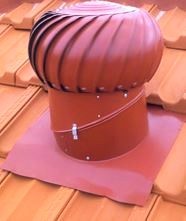Roof Ventilation – Are Whirlybirds The Best Solution?
If you have ever been in the roof space of your house on a sunny day you will know that you very quickly start sweating!
Why it gets hot
Well the average roof size these days is probably around 200m2.
On a clear sunny day that means around a kilowatt of heat per m2 being radiated onto the roof surface.
So 200 x 1 kilowatt = 200 kilowatts of heat . . . That is a lot of heat coming into a small volume!
Even with a light coloured roof that reflects up to 50% of the heat the roof space is still going to get really hot . . . which means the inside of the house will be harder to cool.
Is a whirlybird going to help?
Go round your local DIY shop and you will see plenty of whirlybirds for sale . . . some for less than $100.
Seems cheap, not too difficult, and no running costs, so why not fit one?
Well they may not be as effective as you hope for of several reasons:
- Without an adequate source of incoming air, such as eaves vents or gable vents, the whirlybird will struggle to remove much air from the roof.
- A typical whirlybird will only extract around 100-200 cubic m per hour, not enough to make a large impact when there is 200 kilowatts of heat falling on the roof.
- On a hot still day the effectiveness of the whirlybird will be much reduced. It needs a wind speed of upwards of 5m/sec to be effective.
Typically manufacturers of whirlybirds suggest that at least 3 will be required for a typical domestic roof. . . so do you want your roof to be more like a factory
So what should you do?
- If you are still building choose a light coloured material of even plain galvanised tin to maximise the reflected heat.
- Make sure you have enough incoming air, such as unobstructed eaves vents, or gable vents.
- Consider alternatives such as
Thermostatically controlled mains powered fans (Has low running costs and will remove large volumes of air when you want it removed)
Solar Powered Fans (No running costs and most effective on sunny still days)
A final though is . . . . Installing solar power panels will provide shade for a large portion of your roof reducing the area subject to solar radiation.